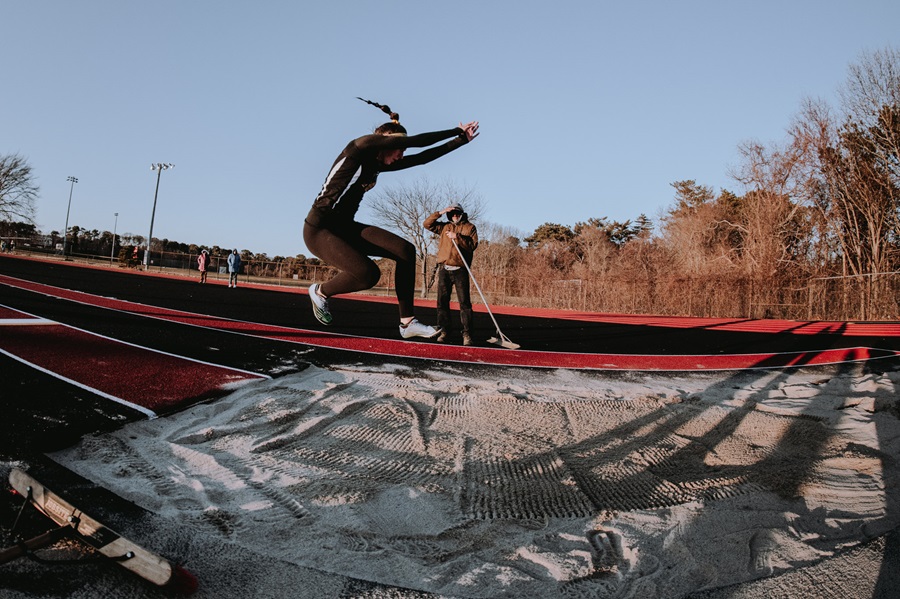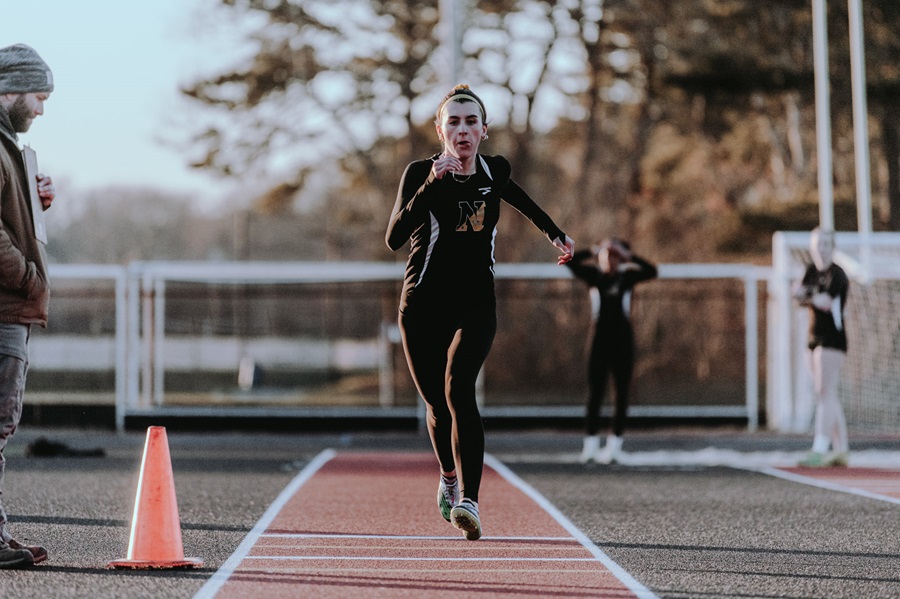EASTHAM — They fly through the air, legs and arms circling to propel their bodies forward, and in an instant they thud into the sand.
“The long jump is one of the most technically challenging events in track and field, as you need to have everything you do from stepping onto the runway to exiting the pit down to a science,” says Nauset High senior long jumper Paytah Dill, who lives in Bourne.
“The margin for error in long jump is nonexistent,” he says. “If you mess up even the smallest thing, like lengthening your first step by half an inch, it most likely results in a foul. If you don’t stand up straight for the latter half of your run-up, you’ll lose feet of distance.”

At the end of the long jump runway is a takeoff board marked with a foul line. The toe of the jumper’s shoe must be behind the foul line when the foot leaves the board.
The distance jumped is measured from the edge of the takeoff board to the closest indentation made by any part of the athlete’s body landing in the sand.
Jumpers calculate every step down to the stride length and explode in a final step with all the force they can muster. And there’s more that must be remembered to be effective: seamlessly cycle your arms and legs, keep your chest high, fold in at the right time. The price for messing one thing up? A wasted jump.
Dill is determined to have very few wasted jumps. During the outdoor track season in his junior year, he didn’t know if he would ever have that sensation of flying through the air again. After each race — in addition to jumping he runs the 55-meter hurdles, both as an individual and with the relay team — he threw up violently and experienced horrible pain. He spent five days at Mass. General Hospital with a top nephrologist on his case. He wondered if he would ever compete again. He was found to have a kidney anomaly.
“I continue to do checkups,” says Dill, “but I know that every time I compete, I run the risk of a relapse.” This year he broke the Nauset long jump record at the Division 4 State Championship with a jump of 20 feet, 7¾ inches. The old record was 20 feet, 3¾ inches. He was also crowned Cape and Islands long jump champion.
“There have been times throughout the winter season when I have had to take a step back,” he says. “Knowing that competing could result in another episode makes it much more meaningful and significant, as I now know that every jump could be my last.”
Long jumpers all want every jump to be better than the last.
“My goal is to jump 17 feet by the end of my sophomore year,” says Violet Roche, who lives in Orleans. Her current personal record is 16 feet, 10 inches, two inches shy of her target. “That pushes me to want to jump farther and put the work and practice in — that and seeing others jump far makes you want to go jump even further,” says Roche.
Her coach stretches her arms in preparation. Having loose arms helps her fling herself forward.

Roche and Dill both use deep breathing to focus on what they need to do to have a successful jump. “I prioritize it,” says Dill. “With each breath, the entire world around me quickly fades away — it’s just me and the runway — and I almost black out because I am so locked into what I am doing.”
Dill has practiced deep breathing since freshman year, and it’s become instinctual.
“The mental aspect of jumping is huge,” says Roche, who is also a standout in the high jump. She reached the Meet of Champions in that event and was the Cape and Islands champion with a jump of 5 feet, 2 inches. “I struggled with fouling this season, so focusing on getting a jump on the board is big for me,” she says.
There’s something fanatical about long jumpers. They become obsessed with tiny details, and they are driven by the desire to go one inch farther. There’s always something more.
“Everyone had to listen to me every day say over and over that I was going to break the record and that I’m going to qualify for the next and bigger meet,” says Dill. “The record was a foot longer than my longest jump, but every part of me believed that I would break it. There was no other choice.”



